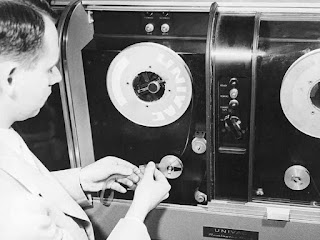STORAGE DEVICE
Storage device is one of three part of computer. There
are two types of storage on a computer namely Primary and Secondary. Primary
storage of volatile and non volatile. Volatile memory holds data for temporary
either electricity goes are computer gets restarted somehow all data get lost.
Non volatile primary storage helps start your computer. This contains some very
useful firmware to boot with computer. Booting is the process of starting
computer. Actually this type of storage is called main memory. Secondary memory
is what we used to hold our data for a long period. Secondary storage comes in different forms.
Floppy disk, Hard disk and optical disk are a few to name.Primary Storage
Memory is a working storage of computer. This is very
important part of computer where data, information and programs are kept during
processing and are retrieved if needed. Memory is also called primary memory
are main memory. Memory uses some spaces for storage that is definite in number
called capacity or size of memory.Computer primary memory is mainly of two types-
1. RAM [Random Access Memory]
2. ROM [Read Only Memory]
RAM
Random access memory is the same as main memory is
volatile, means the contents of the memory disappear once the current is turned
off. Ram is found in different size 4MB, 8MB, 16MB, 32MB, 64MB, 128MB, 256MB,
512MB and 1GB etc.Several types of Ram used in Personal Computer-
- Dynamic RAM [DRAM]
- Synchronous DRAM [SDRAM]
- Static RAM [SRAM]
ROM
Read only memory is a permanent memory of computer.
Programs are built into Ram at the factory label and cannot be changed by the
user, we can read them, but not alter. ROM is non volatile the contents do not
disappear when the current is turned off. Rom is of the following types-- PROM [Programmable Read Only Memory]
- EPROM [Erasable Programmable Read Only Memory]
- EEPROM [Electrical Erasable Programmable Read Only Memory]
Secondary Storage
Secondary storage also called auxiliary storage is found
physically outside the processor. This is a long term non volatile memory.
Though Rom is also non- volatile memory to which data cannot be added. Besides
storing data, secondary storage is also use full for transferring them from one
computer to another. There are a number of s. storage devices. They can broadly
be classified into Magnetic tape, Magnetic Disk and Optical disk.
Magnetic Tape
Magnetic tape is non-volatile storage medium
consisting of a magnetic contain on a thin plastic of strip. Nearly all
recording tapes are of this type, whether used for video, audio storage or
general digital data storage using a computer.Magnetic Disk
Magnetic disk is another form of sequential access
storage, but it is for better for direct for direct access storage. A magnetic
disk can be of two forms-- Hard Disk
- Floppy Disk
Hard disk
Hard disk is a non-value storage device which store
digitally encode data on rapidly rotating plot here with magnetic surf case
hard disk ware originally developed for use with computer. Today, applications
for hard disk have expanded beyond computers to in clued digital video
recorders, digital audio players, and digital camera and video game consoles.
Mobile phones from Samsung and nailed can be found with HDDS.Floppy Disk
Floppy disks are mode of Magnetic Oxide coated
flexible tape material. It is enclosed in a rectangle plastic jacket. Floppy
disks are the following two type-1. Mini floppy
2. Micro floppy
Optical disk
In optical disk is a flat, usually polycarbonate disk
whereon data is stored in the form of pits within a flat surface. This data is
generally accessed when a special material on the disk (often aluminum) is
illuminated with a laser diode. These pits distort the replanted laser light.Optical disk are compact disk following.
- CD [Compact Disk]
- DVD [Digital Versatile Disk]
- BD [ Blu -Ray disk]






No comments:
Post a Comment